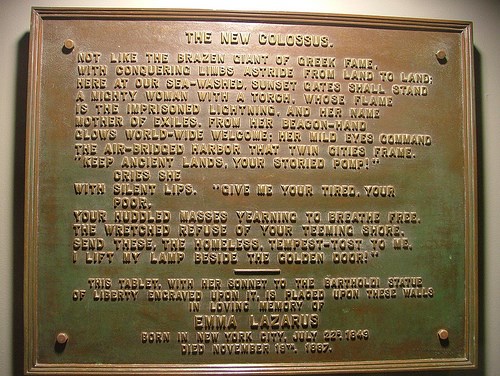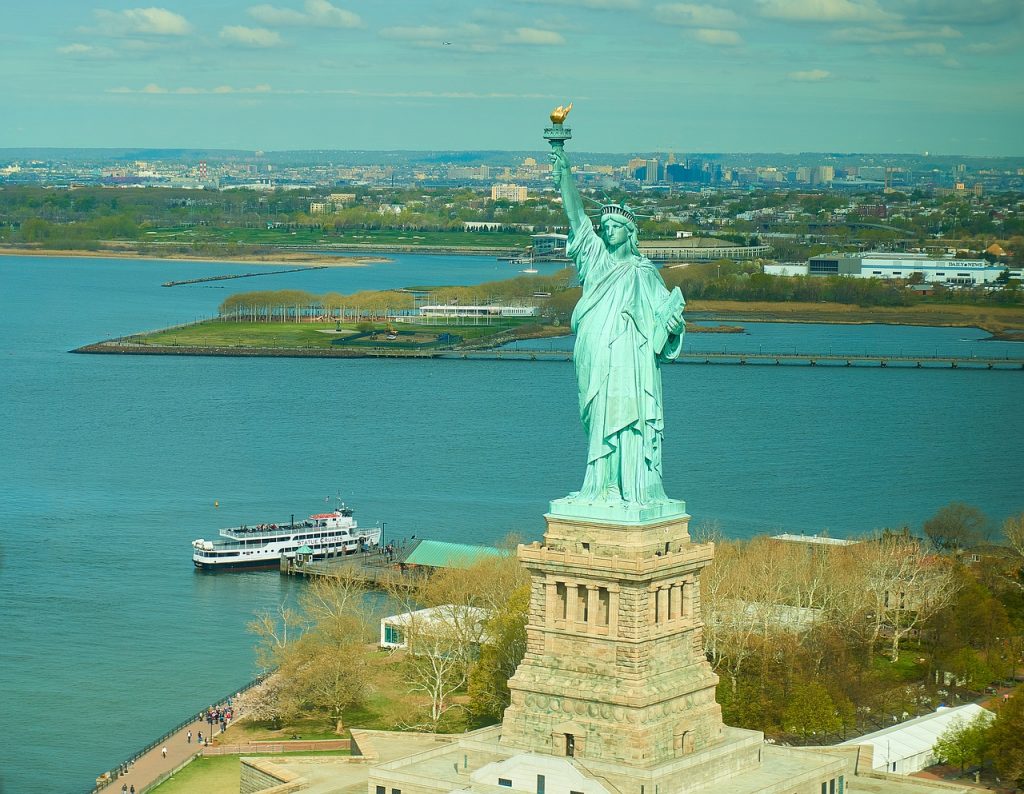
When the idea for the Statue of Liberty was first conceived, many people were critical and even more were skeptical. Over 130 years later, the statue still stands, and it serves as a beacon of hope and a living symbol of freedom to millions of people around the world. In this post, we’ll break down that journey step by step as we explore the complete history of Lady Liberty.
1865
During an after-dinner discussion, French politician and abolitionist Edouard de Laboulaye proposed that his country should gift a statue to the United States for the centennial celebration of the Declaration of Independence. The recent Union victory in the Civil War reaffirmed Laboulaye of the country’s ideals of freedom and democracy. He felt that showing public support for the U.S. would also strengthen the fight for democracy in France.
1870
Laboulaye turns to Auguste Bartholdi, a young, French sculptor who is both supportive of Laboulaye’s proposal and fascinated by colossal statues. In 1870, he created the first models of his concept. Considering how to best express the idea of liberty, he chooses a female figure cloaked in robes, striding over a broken chain. In her right hand, a torch to represent progress. In her left, a tablet inscribed with the date of the Declaration, evoking the concept of the law.
1871
In order to promote the statue and decide on a site, Bartholdi visited the U.S. in June of 1871. He chooses Bedloe’s Island, in New York Harbor, as the location. He also meets with multiple American politicians and publishers who he believes will be supportive to his project.
1875
Laboulaye approves Bartholdi’s plaster model of the statue’s design. They refer to it as “Liberty Enlightning the World”. In September, the project was announced and the Franco-American Union was formed to oversee fundraising for the statue. It is agreed that the French will fund the statue if the people of America fund the pedestal.
1876
Construction for the statue begins at the Gaget, Gauthier & Co, workshop. In May, her right hand and torch were sent to the United States and displayed at the Centennial Exposition in Philadelphia. Visitors could even climb up to the balcony of the torch.
1877
After the exhibition in Philadelphia closed, the arm was moved to New York and displayed in Madison Square Park. It stayed for several years (until 1882) and was then brought back to France to join the rest of the statue. That same year, the United States began fundraising for the construction of the pedestal.
1878

Once Bartholdi returned from the United States, he concentrated on completing the head and shoulders. Both were put on display at the Paris Universal Exposition/World’s Fair. Fundraising continued throughout France – offering mini models of the statue, tickets to view construction and a prize lottery.
1879
Eugene Viollet-le-Duc, the statue’s engineer, dies before completing the structure for the inside. Bartholdi hires designer and builder Gustave Eiffel to complete the project. He came up with the idea for an iron truss tower to support the height and weight of the statue – a 98 foot inner framework. He also included two interior spiral staircases, to make it easier for visitors the reach the observation point in the crown. Unfortunately, the arm was too narrow for a similar staircase, so access to the platform on the torch could only be done by ladder.
1881
Amercian architect Richard Morris Hunt is chosen to design the pedestal. In a few months, he will submit a detailed design plan. His original idea planned for the pedestal to be 114 feet, but financial issues forced that to be reduced to 89 feet. Construction was expected to take around 9 months.
1882
Fundraising for the pedestal begins in the U.S. As part of this, poet Emma Lazarus is asked to donate an original work to an auction of art and manuscripts. At the time, she was aiding refugees in New York who had fled antisemitic pogroms in eastern Europe. She wrote a sonnet to express her empathy for the refugees in terms that applied to the statue. Entitled “The New Colossus”, this sonnet would eventually become the single most famous piece of writing about the Statue of Liberty.
1883
The statue begins assembly in Paris. Meanwhile, construction begins on the pedestal.
1884
Assembly of the statue is complete and it’s formally presented at a ceremony in Paris. But there’s trouble over in New York. With the statue scheduled to arrive the next year, funds for the pedestal run out and construction stops. Seeing that the project was in jeopardy, other major cities like Boston and Philadelphia offered to pay full price for the cost of relocating the statue.
1885
Famed publisher Joseph Pulitzer steps in to help aid in fundraising. He hosts a six-month fundraising campaign with his newspaper, the “New York World.” Promising to print the name of every person who donated (no matter how small the amount) over $100,000 was raised. As donations poured in, work resumed on the pedestal. Once sufficient progress was made, the statue was disassembled and stored in crates for its journey to America. It arrived in New York Harbor on June 17th. But the pedestal was not yet done, so it waited in storage for almost a year.
April 1886
Once the pedestal was finally completed, reassembly work began on the statue.
October 28, 1886

With the statue finally complete, an official unveiling and dedication ceremony takes place on Bedloe’s Island. The attendees are almost exclusively men. In Manhattan, the city holds its first ever Ticker-Tape Parade in honor of the dedication. Over one million people attend. Unfortunately, due to fog and rain, the statue isn’t even visible from the mainland.
1892
Ellis Island opens. From then on, millions of immigrants would pass by the statue as they entered America for the first time. To them, she was a symbol of hope, enlightenment and welcome. It was at this point that many started to associate the Statue of Liberty with immigration.
1903
The famous sonnet by Emma Lazaurs, “The New Colossus” is inscribed on a plaque and mounted to the base of the statue. At the same time, the oxidation of Lady Liberty’s copper skin starts to become noticeable. The green patina would eventually completely cover the statue by 1906.
July 30, 1916
WWI German spies set off an explosion on Black Tom Island in Jersey City. Dynamite and explosives set for the British and French war effort were detonated. That statue suffered some minor damage (mostly to the right arm and torch) and closed for ten days. For public safety reasons, the torch balcony has been closed ever since.
1924
President Calvin Coolidge designates the statue a National Monument.
October 28, 1936
The 50th anniversary of the Statue of Liberty is celebrated on Bedloe’s Island. The following year, the War Deparment gave control of the island to the National Parks Service and they began development of a master plan for the island to be turned into a park.
1956
Bedloe’s Island is officially renamed Liberty Island thanks to a joint resolution in Congress.
1976

The statue is designated a New York City landmark. A year later, a tablet celebrating Emma Lazarus’ life and work is placed next to “The New Colossus” tablet.
1982
In 1982, it was announced that the Statue of Liberty was in need of some restoration. Lee Iacocca is appointed head of the Statue of Liberty-Ellis Island foundation by Ronald Regan. His first task is to assess the current condition of the statue and provide details on needed work. Meanwhile, over $350 million is raised in donations to the foundation.
1984
Restoration work begins. That same year, the Statue of Liberty was designated a UNESCO World Heritage Site.
1986
The renovation work is completed and the statue reopns on July 4th weekend. The original torch is removed and replaced. The “New Colossus” plaque is relocated inside the new Statue of Liberty Exhibit in the pedestal. On October 28, the centennial is officially celebrated with officials from France and the United States.
September 11, 2001
Just as the first ferry of the day was about to depart, the World Trade Center was attacked. Both Liberty Island and Ellis Island were immediately closed.
December 1, 2001
Liberty Island reopens to the public, but access to the pedestal and/or the statue is not permitted.
August 3, 2004
The inside of the pedestal reopens to the public after being closed for almost 3 years. But the inside of the statue still remains off limits.
2007

Statue Cruises replaces Circle Line as the official transportation and ticketing operator for the Statue of Liberty and Ellis Island.
July 4, 2009
The crown of the statue reopens to the public for the first time since 9/11. But only a limited number of visitors are allowed per day and reservations must be made in advance.
October 28-29, 2011
The Statue of Liberty celebrates 125 years. The next day, the interior of the pedestal closes for renovation.
October 28-29, 2012
On October 28, the inside of the statue reopens after the year long renovation. The following day, Hurricane Sandy floods most of Liberty Island, so it’s forced to close (along with Ellis Island) until repairs can be made.
July 4, 2013
The Statue of Liberty finally reopens to the public while repairs continue on Liberty Island. Ellis Island would remain closed for several more months.
October 7, 2016
Construction on the new Statue of Liberty museum begins on Liberty Island. The brand new space is accessible to everyone who visits the island. It officially opens almost 3 years later, in May of 2019.
March 16, 2020
Due to the COVID-19 pandemic, the Statue of Liberty is closed to the public. It doesn’t reopen again until July 20, 2020.
Visiting the Statue of Liberty

Now that you know the story, come experience the statue for yourself. You can learn even more when you join with a local guide. We’re dedicated to providing you the best experience possible with the Statue of Liberty and hope that you leave with more respect and appreciation for her than ever.
